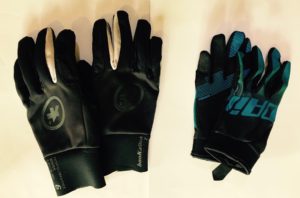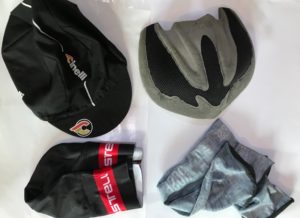The easiest thing to do is to stare out of the window and put off the ride that you have looked forward to until another day. But you remind your inner self that you have committed to improve your fitness, and it really is down to you; fitness and the sense of true well-being don’t just appear by watching Saturday Kitchen, for some perhaps, but that’s a guilty pleasure 🙂
So you pace around the house like a caged cat, knowing you want to ride, knowing you should ride, but how can it be possible when it looks so blinking freezing outside ? I’m not going to advocate that you just “man up” or apply Rule #5 (which is “Harden the ‘f@!k’ up”). That type of advice doesn’t help if by the end of the ride you are frozen to the core, and that self defeating belief that it wasn’t a good idea will just have been reinforced.
So how to get out there without buying eye-watering (and wallet depleting) amounts of cold weather kit ? Here are a few of my favourite tips for staying warm on a budget.
Hands. There are many makes of gloves, some marketed as being for below 10 degrees, others down to freezing point, where do you start ? A simple solution is to buy a good quality pair of long fingered gloves, make sure that they fit you, and make sure you can reach the brakes and change gears while wearing them. In terms of price, at the high end you’ll find gloves from the likes of Rapha at £70, right down to gloves from Aldi at £7.99.
 Cheap is not always best, nor is expensive, so try out a few pairs, and you will find that there are good options in the £20-£30 price bracket. Furthermore, rather than buying uber-expensive sub-zero gloves, buy a pair of silk gloves (for £5 on eBay) instead. Silk has excellent heat retention properties (it is a non-conductor of heat similar to wool), acting as a liner when worn under your normal gloves when temperatures drop.
Cheap is not always best, nor is expensive, so try out a few pairs, and you will find that there are good options in the £20-£30 price bracket. Furthermore, rather than buying uber-expensive sub-zero gloves, buy a pair of silk gloves (for £5 on eBay) instead. Silk has excellent heat retention properties (it is a non-conductor of heat similar to wool), acting as a liner when worn under your normal gloves when temperatures drop.Feet. The vast majority of cycling shoes have been designed primarily for warm, dry weather. You could invest in specialist winter cycling shoes (at a cost), or adopt what most cyclists do and get a pair of “over-shoes”. Now, over-shoes are not designed to be 100% waterproof, but act as a very good wind barrier and will keep your feet reasonably dry and snug unless you get caught in a prolonged downpour. There are many versions, from the toe-cap type to the full shoe cover (see photo).
At this time of year I would suggest the full shoe cover as they will keep your shoes free from all the muck and grit that gets thrown up from the road.
Over-shoes do not need to break the bank, with good options being from the likes of Madison or SealSkinz; both around the £20-£25 price bracket. If you’d like some addtional comfort, buy a quality pair of merino wool socks (circa £7) or my favourite, the sealskinz waterproof socks, slightly more expensive, but if you value dry, warm feet then the investment is more than worthwhile.
Body. The secret is to use layers, and those in the know recommend three. The first layer is for moisture management (to wick sweat away from the body), the second layer for warmth, and the third for bad weather protection.
- The foundation is the base layer. This can be a budget base from Aldi at £7 through to the Castelli base layer at £28, the important things to look for are to ensure that there are no seams that will rub and irritate you, and that the material wicks sweat away from your body to keep you dry.
- After the base layer you need warmth layer. For this you can wear your cycling jersey, either short sleeve or long sleeve, or choose a warmer option using materials such as merino wool or other material that is similarly fleeced. What you are looking to do with the warmth layer is to use clothing that traps air (air is one of the best thermal insulators) between the base and protection layers.
- The protection layer comes in contact with the outside world, so needs to be windproof and waterproof/water resistant. For this layer you have the opti
 on of wearing a gilet (a windstopper for the body) together with arm warmers (see below), or wear a jacket. Every year I am amazed by the huge leaps in development of cycle jackets that can be bought on a budget. You no longer have to spend over a £100 to get a decent jacket that will keep you dry and will not make you become a victim of the infamous “boil in the bag” experience. However, this is the piece of kit that is most essential to maintaining your comfort, so if there is any stretch in your budget, a good quality jacket that fits you is where you should spend it. Things to look for when buying a jacket include good quality zips, elasticated cuffs, the length at the back should cover and hence protect your bottom when you are on the bike, it should be a snug fit, not too loose, include reflective strips and pockets. It must be wind-proof (and shower-proof) and breathable. A good example is the B’TWIN 100 jacket priced at £30, though just to give you an idea of the price range, the high-end Castelli Reflex jacket will set you back £225. So, for the beginner, I recommend you start at the B’TWIN end of the scale.
on of wearing a gilet (a windstopper for the body) together with arm warmers (see below), or wear a jacket. Every year I am amazed by the huge leaps in development of cycle jackets that can be bought on a budget. You no longer have to spend over a £100 to get a decent jacket that will keep you dry and will not make you become a victim of the infamous “boil in the bag” experience. However, this is the piece of kit that is most essential to maintaining your comfort, so if there is any stretch in your budget, a good quality jacket that fits you is where you should spend it. Things to look for when buying a jacket include good quality zips, elasticated cuffs, the length at the back should cover and hence protect your bottom when you are on the bike, it should be a snug fit, not too loose, include reflective strips and pockets. It must be wind-proof (and shower-proof) and breathable. A good example is the B’TWIN 100 jacket priced at £30, though just to give you an idea of the price range, the high-end Castelli Reflex jacket will set you back £225. So, for the beginner, I recommend you start at the B’TWIN end of the scale.
Arms/Legs. At some point you will want to think about how to protect your arms and legs from the cold. Let’s ccnsider the legs first. The obvious way is to wear long legged bibs or tights, and this will be the option for most people. However, if you want to continue to wear your cycling shorts, or due to the UK’s changeable weather you cannot decide on shorts or leggings, you can complement your shorts with leg warmers. These are designed to be worn under the shorts from the mid-point of the thigh to the ankle. If you choose this route, then you have the versatility of removing them if the weather improves on the ride, or quickly putting them on if the weather is poor or deteriorates. In a similar vein, if you do not want to wear long sleeved jerseys or a jacket, combined with the base layer and gilet for protection, arm warmers are a good alternative. If in doubt, wear a long legged bib and a jacket as your protection layer.
Head/Neck: A good starting point is to wear a buff. This is a highly versatile peice of kit that can not only keep your neck warm, but also be used to cover your chin, protecting you from a biting wind. Castelli’s “head thing” is amazing as it can also transform into a skull cap and a balaclava ! if you want to use it just as a neck warmer, then I recommend wearing either a separate skull cap, balaclava or just wear a cycling cap.
It depends on how cold it is, how warm your head feels and how folically challenged you are. If on a budget, a simple buff (costing circa £10) and a cycling cap (another £10) will do most conditions in the UK.
So there you have it. For the budget conscious you can be fully kitted for £125 if you follow the above advice.



